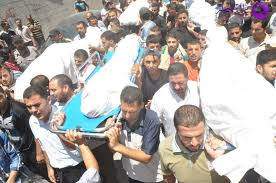
Looking a little closer at the B’Tselem website that claims to catalogue the civilian status of all people killed in Gaza two years ago, we see this:
‘Issam Muhammad ‘Ata a-Najar. 23 years old, resident of Qizan a-Najar, Khan Yunis district. Killed on 29 Jul 2014, in Qizan a-Najar, Khan Yunis district, by gunfire from an aircraft. Did not participate in hostilities. Additional information: Killed in his home together with 15 other members of his family in a strike on the homes of the a-Najar extended family. The strike destroyed two of the family’s homes, in each of which eight people were killed. Other houses were damaged.
Ata Muhammad ‘Ata a-Najar. 28 years old, resident of Qizan a-Najar, Khan Yunis district. Killed on 29 Jul 2014, in Qizan a-Najar, Khan Yunis district, by gunfire from an aircraft. Did not participate in hostilities.
The IDF, in a report released last year, disagrees in a couple of aspects of this categorization:
According to the factual findings collated by the FFA Mechanism and presented to the MAG, at the time in question the IDF had attacked a Hamas military command and control center located in a building in Khan Younis, as well as senior Hamas operatives who were manning the center at that time. During the attack planning process, it was assessed that there might be a number of civilians present in the building, but that the potential harm to them would not be excessive in relation to the significant military advantage anticipated to result from the attack. The attack on the building was planned for execution by means of a precise munition, and in a manner that would allow the operational purpose of the attack to be achieved, whilst minimizing the potential harm to the surrounding buildings. As a result of the attack, eight individuals were killed, among them two Hamas operatives, Asam Mohammad Ata Al Najjar and Ata Mohammad Ata Al Najjar.
After reviewing the factual findings and the material collated by the FFA Mechanism, the MAG found that the targeting process in question accorded with Israeli domestic law and international law requirements. The decision to attack was taken by the competent authorities, and was aimed at lawful targets. The attack complied with the principle of proportionality, as at the time the decision to attack was made, it was considered that the collateral damage expected from the attack would not be excessive in relation to the military advantage anticipated from it, and this estimation was not unreasonable under the circumstances. Moreover, the attack was carried out after a number of precautionary measures had been undertaken, which aimed to minimize the potential for civilian harm, particularly with regard to any civilians present in adjoining buildings. It was also found that the provision of a specific warning prior to the attack, to the persons present in the structure, was not required by law and would have been expected to result in the frustration of the attack’s objective.
In light of these findings, the MAG did not find that the actions of IDF forces gave rise to reasonable grounds for suspicion of criminal misconduct. As a result, the MAG ordered the case to be closed, without opening a criminal investigation or ordering further action against those involved in the incident. Nonetheless, the MAG found it appropriate to recommend to the command authorities that a number of aspects relating to the implementation of the relevant operational instructions be clarified, with an emphasis on improving the documentation of planning procedures for attacks on targets of this type.
Interestingly, the Meir Amit center identified both Issam and Ata as members of Hamas, but could not identify them as militants.
Were they legitimate targets?
The IDF says it was not only targeting the two Hamas members, but also their command and control center that they were running in their house, effectively making their civilian family members human shields. There is no way B’Tselem (or any other NGO) could know whether the house was a command center. Nevertheless, the IDF clearly was targeting Ata and Issam, or else they could not say that a warning “would have been expected to result in the frustration of the attack’s objective.”
It is not unreasonable to believe that Hamas would enlist their paid employees to do military functions during wartime.
This is one of the grey areas where NGOs who confidently publish what seem to be exact figures could easily be wrong, since they cannot possibly know all the details. The media reports the NGO figures without question. Of course any survivors would claim that the victims were all innocent, but interviews seem to be B’Tselem’s main method of determining whether a target was legitimate or not.
What is clear is that B’Tselem had read the IDF account of the incident from a full year ago and chose not to even mention it as a possibility when they were writing up their data claiming that Ata and Issam were certainly civilians. B’Tselem simply decided that the IDF account is wrong and their investigation, almost certainly based on interviews, is more accurate.
It is unethical to not even mention the results of the IDF investigation into the incident. If this is B’Tselem’s methodology, then the methodology is proven to be flawed from just this case. It should at the very least put these two Hamas members in their “Unknown” category for those that they were unsure about.
There is another major discrepancy between the IDF and B’Tselem accounts: the number of victims. It is possible that both are telling the truth; the IDF only referring to the specific family home that the two Najjar Hamas operatives were in, and B’Tselem including the neighboring home that was also destroyed. Yet there is a third possibility – that B’Tselem is wrong about the number of victims, since it seems to be at the mercy of Palestinian records, and we have seen exaggerations (even with names) of the number of victims of previous attacks.
 We have lots of ideas, but we need more resources to be even more effective. Please donate today to help get the message out and to help defend Israel.
We have lots of ideas, but we need more resources to be even more effective. Please donate today to help get the message out and to help defend Israel.

Leave a Reply